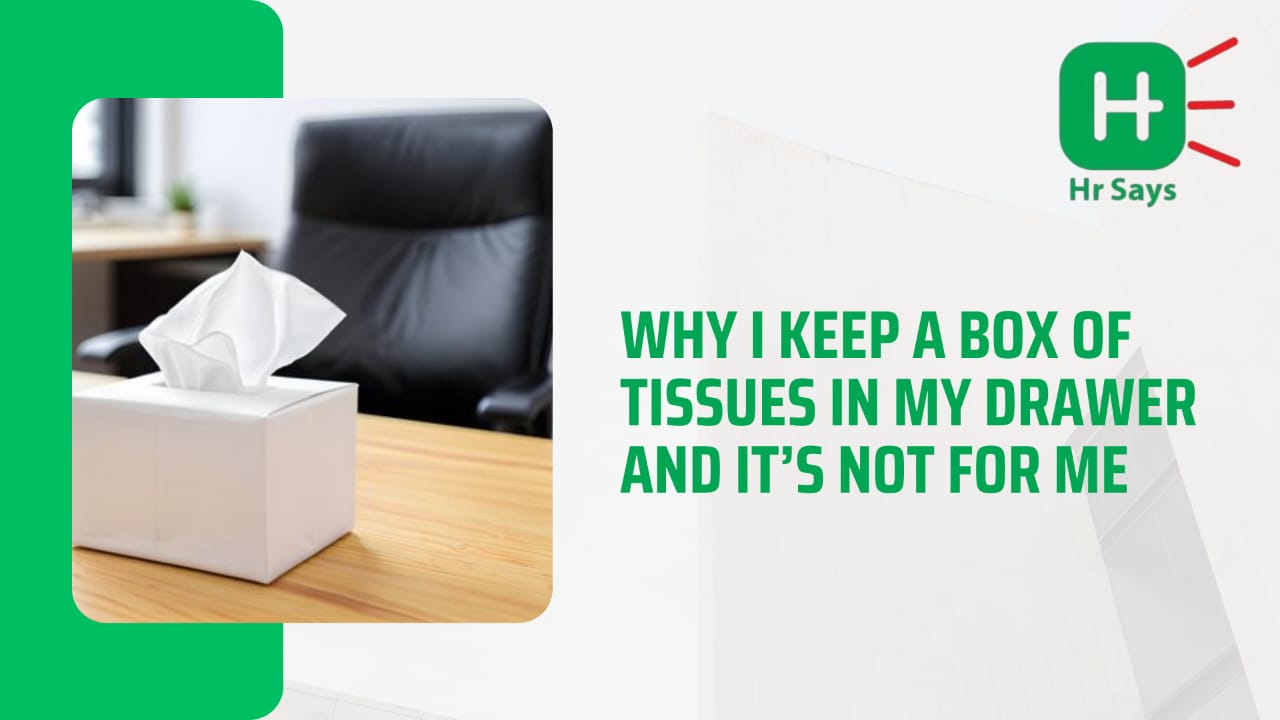There’s a drawer in my office desk that rarely gets noticed. It doesn’t have policy documents or HR forms or a stash of chocolates for long meetings. It holds a single thing (a box of tissues). And no, it’s not for my occasional cold or allergy season. It’s there because, more often than you’d believe, someone walks in and breaks down.
HR is many things including strategy, compliance, analytics. But behind every dashboard and every talent report, there’s a side of HR no one talks about. The one where you sit across from someone who’s holding it together by a thread. Where you hear stories that never make it to performance reviews. The ones that don’t fit into any policy.
People think of HR as the place you go when something needs to be fixed like salary errors, appraisal issues or exit formalities. But sometimes, people come just to feel heard. And when they do, they don’t bring bullet points. They bring heartbreak. They bring confusion, fear, loss, burnout, anxiety. And we listen. That’s our job. That’s the part they don’t teach you in any certification.
I’ve had people cry in front of me because they felt invisible. Because they were passed over for a role they thought they deserved. Because they were managing a parent’s chemotherapy while pretending to be “normal” in meetings. Because they were a new mother torn between feeding schedules and OKRs. Because they were being bullied quietly. Because they were scared of being let go.
And what do you do in those moments? You can’t quote the policy. You can’t open the employee handbook. All you can do is offer them the box of tissues. Sit in silence. Maybe say, “It’s okay to cry.” And in doing so, you hold space for someone’s pain without judgment, without fixing, without rushing.
That box of tissues is a symbol. It’s a quiet witness to the emotional weight HR carries every single day. We absorb what others release. We stay strong when someone else is falling apart. And then we go back to our spreadsheets, our dashboards, our reports because the work must go on.
What nobody sees is how often we take that pain home. Not the details, not the names but the residue. The weight of knowing someone’s world is cracking and you can only do so much. The guilt of saying “we’ll try” when you know the decision is already made. The helplessness of watching good people leave because they’re burnt out and nobody noticed in time. The tears we hold back because “HR has to be composed.”
I once had a colleague ask me, “Does it get easier?” I didn’t know what to say. You learn to navigate it better, yes. You learn to listen without crumbling, to respond without reacting. But no, it never gets easier when a human being trusts you with their most vulnerable truth. It’s a privilege, but it’s also a silent burden.
There are days we celebrate. When a promotion finally comes through. When a long battle ends in fairness. When someone says, “Thank you for believing in me.” But those are fewer than most think. The truth is, HR is often a lonely space. We’re expected to protect the company and the employee often in the same breath. We’re supposed to be neutral, yet empathetic. Strategic, yet emotional. It’s a balance that demands more than policy knowledge, it demands heart.
That’s why I keep that box of tissues. Because I never want to forget that HR is about people first. Not performance cycles or engagement surveys. But people who are messy, complex, brilliant, struggling, unpredictable. And when one of them walks into my cabin needing more than just a solution, I want them to know this is a safe space. Not because the furniture is cozy or the posters say “we care,” but because someone is ready to sit with their truth.
We live in a time where “employee experience” is a trending term. Where there’s a tool or a dashboard for everything. But no tool can replace the moment a person feels truly seen. Not assessed, not managed, not “addressed” but seen. And HR, at its core, should be the function that sees what others miss.
Of course, we need the policies, the analytics, the data. We need the ability to scale and make tough decisions. But we also need to keep the human in human resources. And sometimes, that starts with the smallest things like a tissue box, a quiet corner, a moment of patience, a willingness to listen.
The world doesn’t often acknowledge the emotional labor of HR. There are no ratings for how many people you comforted. No incentives for how many breakdowns you held space for. No metrics for the weight you silently carried so others could feel a little lighter.
But we know.
We know because we live it. And we’ll keep doing it. Not for recognition. But because that’s what real HR looks like. Not just shaping culture but feeling it. Not just driving engagement but holding someone’s hand when they’ve disengaged from life itself.
So, the next time someone asks me what’s in my drawer, I’ll smile and say, “Just tissues.” But I’ll know. And maybe, just maybe, someone out there in another HR cabin has the same box, the same story, the same unseen strength. And that’s what binds us in this work. Not the frameworks. Not the fancy conferences. But the quiet, dedicated commitment to be there when it matters most.

 We also need to keep the human in human resources. And sometimes, that starts with the smallest things like a tissue box, a quiet corner, a moment of patience and willingness to listen.
We also need to keep the human in human resources. And sometimes, that starts with the smallest things like a tissue box, a quiet corner, a moment of patience and willingness to listen.












.jpeg)
.jpeg)

.jpeg)

.jpeg)


.jpeg)

.jpeg)

.jpeg)


